43 胎儿染色体非整倍体(T21、T18、T13)检测试剂盒(高通量测序法)指导原则(征求意见稿)+
- 格式:docx
- 大小:324.15 KB
- 文档页数:24

常见肿瘤AJCC 分期手册(第八版)目录(一)头颈部肿瘤鼻咽癌 (4)鼻腔和鼻窦肿瘤 (5)HPV 相关性(P16+)口咽癌 (7)唇和口腔癌 (8)大涎腺肿瘤 (9)喉癌 (10)口咽(P16-)和喉咽癌 (12)头颈部的恶性黑色素瘤 (14)结膜癌 (15)结膜黑色素瘤 (16)泪腺癌 (17)葡萄膜黑色素瘤 (18)视网膜母细胞瘤 (20)眼睑癌 (21)眼眶肉瘤 (22)甲状腺肿瘤 (23)甲状腺髓样癌 (25)甲状旁腺癌 (26)(二)胸部肿瘤肺癌 (27)乳腺癌 (29)食管癌/食管与胃食管交界处肿瘤 (31)胸腺肿瘤 (34)恶性胸膜间皮瘤 (35)(三)腹部消化系统肿瘤肝癌 (36)肝内胆管细胞癌 (37)胆囊癌 (38)Vater 壶腹癌 (39)肝门胆管癌 (40)远端胆管癌 (41)胃癌 (42)胰腺癌 (44)结直肠癌 (45)阑尾肿瘤 (47)小肠癌 (49)肛门肿瘤 (50)(四)腹部泌尿系统肿瘤肾肿瘤 (51)肾盂和输尿管癌 (52)膀胱癌 (53)尿道癌 (54)(五)生殖系统肿瘤前列腺癌 (55)阴茎癌 (57)睾丸青春期后生殖细胞肿瘤及恶性性索间质肿瘤 (58)宫颈肿瘤 (60)卵巢、输卵管肿瘤和原发性腹膜癌 (62)子宫体肿瘤 (64)滋养叶细胞肿瘤 (65)阴道癌 (66)女性外阴癌 (67)(六)黑色素瘤、肉瘤及间质瘤皮肤恶性黑色素细胞瘤 (68)四肢和躯干软组织肉瘤 (70)乳腺肉瘤 (71)乳腺叶状肿瘤 (72)腹部和胸腔内脏器官软组织肉瘤 (73)腹膜后软组织肉瘤 (74)胆囊肉瘤 (75)肾肉瘤 (76)子宫体肉瘤 (77)胃肠道间质瘤 (79)(七)神经内分泌肿瘤结肠、直肠神经内分泌肿瘤 (80)空肠回肠神经内分泌肿瘤 (81)阑尾神经内分泌肿瘤 (82)肾上腺神经内分泌肿瘤 (83)十二指肠和Vater 壶腹神经内分泌肿瘤 (84)胃神经内分泌肿瘤 (85)胰腺神经内分泌肿瘤 (86)鼻咽癌适用于:鼻咽上皮性肿瘤。

产前筛查和产前诊断题库(带全部参考答案)A 1B 2C 3D 41.对未取得产前诊断类母婴保健技术考核合格证书的个人,擅自从事产前诊断或超越许可范围的,由县级以上人民政府卫生行政部门(C);情节严重的,按照《中华人民共和国执业医师法》吊销其医师执业证书。
构成犯罪的,依法追究刑事责任A给予警告或者责令暂停一个月以上三个月以下执业活动B给予警告或者责令暂停三个月以上六个月以下执业活动C给予警告或者责令暂停六个月以上一年以下执业活动D给予警告或者责令暂停一年以上两年以下执业活动2.《产前诊断技术管理办法》自(A)开始实施?A2003年5月1日B2002年5月1日C2005年5月1日D2004年5月1日3.下列哪项不是中孕期母血清学产前筛查的主要检查项目?(D)A 唐氏综合征B 18-三体综合征C 开放性神经管缺陷D 13-三体综合征4.中孕期通常指(B)A 15周~20+6 周B 13周~20+6 周C 10周~13+6 周D 16周~22+6周5.中孕期筛查时限通常指(A)A 15周~20+6 周B 13周~20+6 周C 10周~13+6 周D 16周~22+66.产前筛查是指通过简便、经济和较少创伤的检测方法,从孕妇群体中发现某些有(A)的高风险孕妇,以便进一步明确诊断。
A 先天性缺陷和遗传性疾病胎儿B 先天性缺陷和传染性疾病胎儿C 先天性缺陷和痴呆儿D 先天性缺陷和无脑儿7.中孕期母血清学产前筛查是指通过中孕期母体血清甲胎蛋白、血清人绒毛膜促性腺激素、血清人绒毛膜促性腺激素游离β亚基、抑制素A和非结合雌三醇指标结合孕妇的年龄、体重、孕周、病史等进行综合风险评估,得出胎儿罹患(C)的风险度。
A 唐氏综合征、13三体综合征和开放性神经管缺陷B 唐氏综合征、18三体综合征和神经管缺陷C 唐氏综合征、18三体综合征和开放性神经管缺陷D 唐氏综合征、21三体综合征和开放性神经管缺陷8.下列哪项不是中孕期母血清学产前筛查的生化指标?(D)A 血清甲胎蛋白B血清人绒毛膜促性腺激素 C 非结合雌三醇 D 孕妇的年龄9.产前筛查应按照(B)的原则,医务人员应事先告知孕妇或其家属产前筛查的性质。
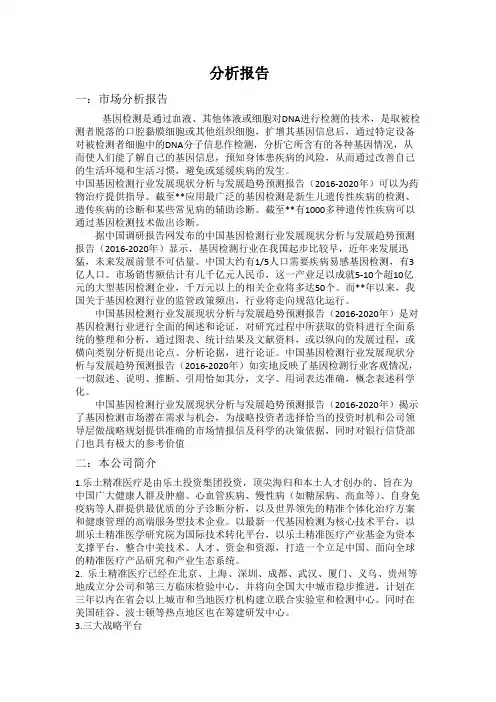
分析报告一:市场分析报告基因检测是通过血液、其他体液或细胞对DNA进行检测的技术,是取被检测者脱落的口腔黏膜细胞或其他组织细胞,扩增其基因信息后,通过特定设备对被检测者细胞中的DNA分子信息作检测,分析它所含有的各种基因情况,从而使人们能了解自己的基因信息,预知身体患疾病的风险,从而通过改善自己的生活环境和生活习惯,避免或延缓疾病的发生。
中国基因检测行业发展现状分析与发展趋势预测报告(2016-2020年)可以为药物治疗提供指导。
截至**应用最广泛的基因检测是新生儿遗传性疾病的检测、遗传疾病的诊断和某些常见病的辅助诊断。
截至**有1000多种遗传性疾病可以通过基因检测技术做出诊断。
据中国调研报告网发布的中国基因检测行业发展现状分析与发展趋势预测报告(2016-2020年)显示,基因检测行业在我国起步比较早,近年来发展迅猛,未来发展前景不可估量。
中国大约有1/5人口需要疾病易感基因检测,有3亿人口。
市场销售额估计有几千亿元人民币,这一产业足以成就5-10个超10亿元的大型基因检测企业,千万元以上的相关企业将多达50个。
而**年以来,我国关于基因检测行业的监管政策频出,行业将走向规范化运行。
中国基因检测行业发展现状分析与发展趋势预测报告(2016-2020年)是对基因检测行业进行全面的阐述和论证,对研究过程中所获取的资料进行全面系统的整理和分析,通过图表、统计结果及文献资料,或以纵向的发展过程,或横向类别分析提出论点、分析论据,进行论证。
中国基因检测行业发展现状分析与发展趋势预测报告(2016-2020年)如实地反映了基因检测行业客观情况,一切叙述、说明、推断、引用恰如其分,文字、用词表达准确,概念表述科学化。
中国基因检测行业发展现状分析与发展趋势预测报告(2016-2020年)揭示了基因检测市场潜在需求与机会,为战略投资者选择恰当的投资时机和公司领导层做战略规划提供准确的市场情报信及科学的决策依据,同时对银行信贷部门也具有极大的参考价值二:本公司简介1.乐土精准医疗是由乐土投资集团投资,顶尖海归和本土人才创办的、旨在为中国广大健康人群及肿瘤、心血管疾病、慢性病(如糖尿病、高血等)、自身免疫病等人群提供最优质的分子诊断分析,以及世界领先的精准个体化治疗方案和健康管理的高端服务型技术企业。
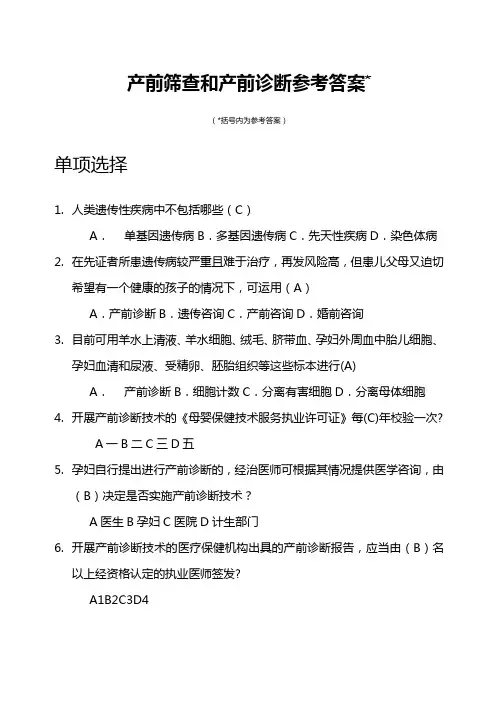
产前筛查和产前诊断参考答案*(*括号内为参考答案)单项选择1.人类遗传性疾病中不包括哪些(C)A.单基因遗传病B.多基因遗传病C.先天性疾病D.染色体病2.在先证者所患遗传病较严重且难于治疗,再发风险高,但患儿父母又迫切希望有一个健康的孩子的情况下,可运用(A)A.产前诊断B.遗传咨询C.产前咨询D.婚前咨询3.目前可用羊水上清液、羊水细胞、绒毛、脐带血、孕妇外周血中胎儿细胞、孕妇血清和尿液、受精卵、胚胎组织等这些标本进行(A)A.产前诊断B.细胞计数C.分离有害细胞D.分离母体细胞4.开展产前诊断技术的《母婴保健技术服务执业许可证》每(C)年校验一次?A一B二C三D五5.孕妇自行提出进行产前诊断的,经治医师可根据其情况提供医学咨询,由(B)决定是否实施产前诊断技术?A医生B孕妇C医院D计生部门6.开展产前诊断技术的医疗保健机构出具的产前诊断报告,应当由(B)名以上经资格认定的执业医师签发?A1B2C3D47.对未取得产前诊断类母婴保健技术考核合格证书的个人,擅自从事产前诊断或超越许可范围的,由县级以上人民政府卫生行政部门(C);情节严重的,按照《中华人民共和国执业医师法》吊销其医师执业证书。
构成犯罪的,依法追究刑事责任A给予警告或者责令暂停一个月以上三个月以下执业活动B给予警告或者责令暂停三个月以上六个月以下执业活动C给予警告或者责令暂停六个月以上一年以下执业活动D给予警告或者责令暂停一年以上两年以下执业活动8.《产前诊断技术管理办法》自(A)开始实施?A2003年5月1日B2002年5月1日C2005年5月1日D2004年5月1日9.下列哪项不是中孕期母血清学产前筛查的主要检查项目?(D)A唐氏综合征B18-三体综合征C开放性神经管缺陷D13-三体综合征10.中孕期通常指(B)A15周~20+6周B13周~20+6周C10周~13+6周D16周~22+6周11.中孕期筛查时限通常指(A)A15周~20+6周B13周~20+6周C10周~13+6周D16周~22+612.产前筛查是指通过简便、经济和较少创伤的检测方法,从孕妇群体中发现某些有(A)的高风险孕妇,以便进一步明确诊断。
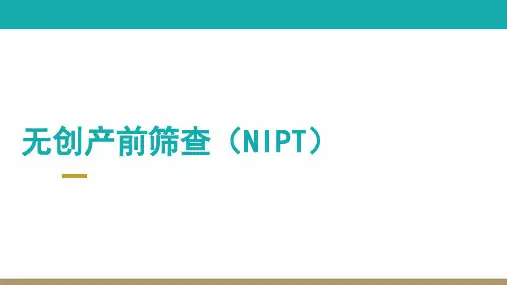
无创产前筛查(NIPT)目录1 2 3背景介绍产品原理产品应用生命天书●23对染色体●约3万个基因●30亿个碱基对●一切生命现象都与基因有关●染色体异常或者基因突变均有可能导致疾病的发生染色体病与基因病检测●染色体病:染色体的数目异常和形态结构畸变,如唐氏综合征,18-三体,Turner综合征,猫叫综合征等●单基因病:基因突变导致的疾病,如遗传性耳聋、苯丙酮尿症、地中海贫血等●染色体病是遗传病中发病率最高的一类(约1.5%),终生难以治愈染色体病通常涉及整条染色体或者多个基因的改变,而基因病是由某个基因引起的疾病。
无创基因检测精度无法检测基因遗传病唐氏综合征●即21-三体综合征,又称先天愚型,是一种染色体疾病,在我国发病率在600~800分之一●在新生儿染色体疾病中,唐氏儿占95%左右,医学上尚无有效的治疗手段。
●主要临床症状:智力低下、五官异常、生长发育迟缓、伴有多系统畸形●我国唐氏患者总计约60万,每年新增唐氏综合征患儿约26600例●每年新出生的唐氏综合征带来的负担超100亿中国出生缺陷防治报告(2012)产前筛查传统的唐氏筛查方法:血清血检测(AFP 、HCG 、uE3等)胎儿颈部透明带超声(NT )唐氏综合征、18三体综合征、开放性神经管缺陷检出率60-70%假阳性率高达5%无创产前胎儿DNA 检测技术(NIPT )21/18/13三体综合征+染色体非整倍体、微缺失/重复准确率>99%产前诊断羊水穿刺绒毛取样脐静脉穿刺染色体非整倍体+易位等结构异常行业金标准侵入性检查存在感染存在一定流产风险我国现行唐氏筛查与预防模式备注:神经管畸形的发病原因通常不是染色体数异常,所以我们现在推出的无创检测技术,是不能检测神经管畸形的。
如果客户遇到了“神经管畸形高危”的问题,还是要咨询医生,借助超声波检测等手段来验证的。
目录1 2 3背景介绍产品原理产品应用胎儿游离DNA (cffDNA )胎儿游离DNA来源:◆几乎全部来源于胎盘滋养层细胞◆胎儿细胞通过胎盘渗透到母血中,被母体免疫系统破坏,胎儿DNA 残留特征●cffDNA 片段比较小,长度在75bp 和250bp 之间,平均仅为166bp ●怀孕5周可检出,8周后含量上升并稳定存在,20周后以比较明显的比例上升。
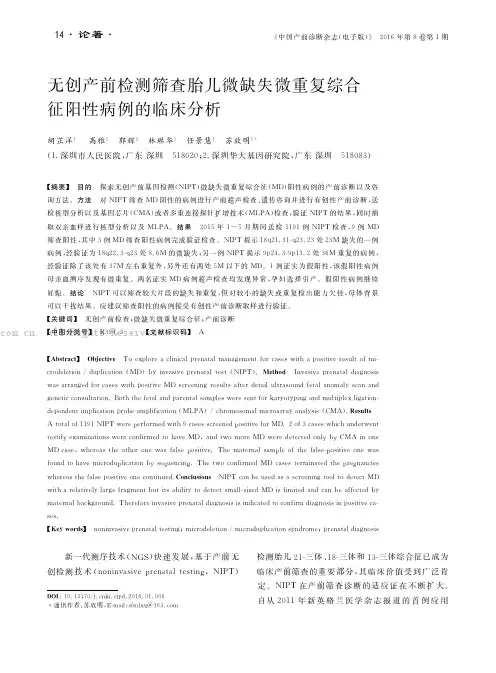
·论著·《中国产前诊断杂志(电子版)》 2016年第8卷第1期无创产前检测筛查胎儿微缺失微重复综合征阳性病例的临床分析胡芷洋1 高雅1 郭辉2 林琳华1 任景慧1 苏放明1(1.深圳市人民医院,广东深圳 518020;2.深圳华大基因研究院,广东深圳 518083)【摘要】 目的 探索无创产前基因检测(NIPT)微缺失微重复综合征(MD)阳性病例的产前诊断以及咨询方法。
方法 对NIPT筛查MD阳性的病例进行产前超声检查、遗传咨询并进行有创性产前诊断,送检核型分析以及基因芯片(CMA)或者多重连接探针扩增技术(MLPA)检查,验证NIPT的结果,同时抽取双亲血样进行核型分析以及MLPA。
结果 2015年1~5月期间送检1191例NIPT检查,9例MD筛查阳性,其中3例MD筛查阳性病例完成验证检查。
NIPT提示18q21.31 q23.23处23M缺失的一例病例,经验证为18q22.3 q23处8.6M的微缺失;另一例NIPT提示9p24.3 9p13.2处36M重复的病例,经验证除了该处有37M左右重复外,另外还有两处5M以下的MD。
1例证实为假阳性,该假阳性病例母亲血测序发现有微重复。
两名证实MD病例超声检查均发现异常,孕妇选择引产。
假阳性病例继续妊娠。
结论 NIPT可以筛查较大片段的缺失和重复,但对较小的缺失或重复检出能力欠佳,母体背景可以干扰结果。
应建议筛查阳性的病例接受有创性产前诊断取样进行验证。
【关键词】 无创产前检查;微缺失微重复综合征;产前诊断【中图分类号】 R394.3 【文献标识码】 A犇犗犐:10.13470/j.cnki.cjpd.2016.01.006 通讯作者:苏放明,E mail:sfmlxq@163.com【犃犫狊狋狉犪犮狋】 犗犫犼犲犮狋犻狏犲 Toexploreaclinicalprenatalmanagementforcaseswithapositiveresultofmi crodeletion/duplication(MD)byinvasiveprenataltest(NIPT).犕犲狋犺狅犱 InvasiveprenataldiagnosiswasarrangedforcaseswithpositiveMDscreeningresultsafterdetailultrasoundfetalanomalyscanandgeneticconsultation.Boththefetalandparentalsamplesweresentforkaryotypingandmultiplexligation dependentimplicationprobeamplification(MLPA)/chromosomalmicroarrayanalysis(CMA).犚犲狊狌犾狋狊 Atotalof1191NIPTwereperformedwith9casesscreenedpositiveforMD.2of3caseswhichunderwenttestifyexaminationswereconfirmedtohaveMD,andtwomoreMDweredetectedonlybyCMAinoneMDcase,whereastheotheronewasfalsepositive.Thematernalsampleofthefalse positiveonewasfoundtohavemicroduplicationbysequencing.ThetwoconfirmedMDcasesterminatedthepregnancieswhereasthefalsepositiveonecontinued.犆狅狀犮犾狌狊犻狅狀狊 NIPTcanbeusedasascreeningtooltodetectMDwitharelativelylargefragmentbutitsabilitytodetectsmall sizedMDislimitedandcanbeaffectedbymaternalbackground.Thereforeinvasiveprenataldiagnosisisindicatedtoconfirmdiagnosisinpositiveca ses.【犓犲狔狑狅狉犱狊】 noninvasiveprenataltesting;microdeletion/microduplicationsyndrome;prenataldiagnosis 新一代测序技术(NGS)快速发展,基于产前无创检测技术(noninvasiveprenataltesting,NIPT)检测胎儿21 三体、18 三体和13 三体综合征已成为临床产前筛查的重要部分,其临床价值受到广泛肯定。
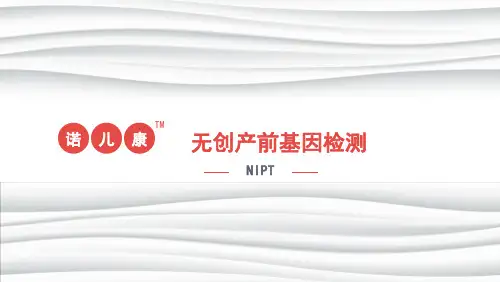

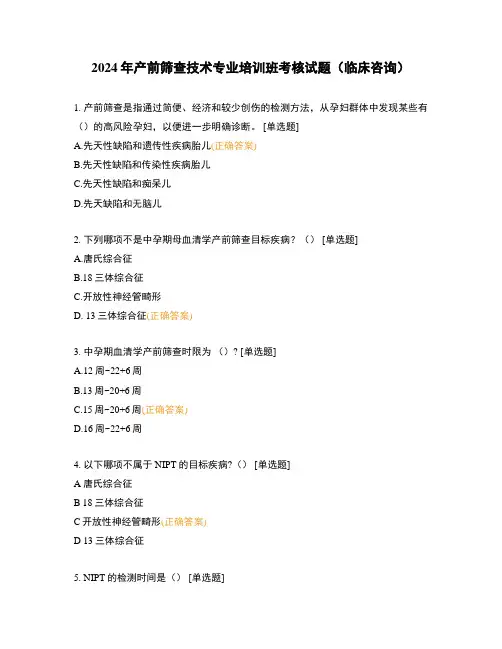
2024年产前筛查技术专业培训班考核试题(临床咨询)1. 产前筛查是指通过简便、经济和较少创伤的检测方法,从孕妇群体中发现某些有()的高风险孕妇,以便进一步明确诊断。
[单选题]A.先天性缺陷和遗传性疾病胎儿(正确答案)B.先天性缺陷和传染性疾病胎儿C.先天性缺陷和痴呆儿D.先天缺陷和无脑儿2. 下列哪项不是中孕期母血清学产前筛查目标疾病?() [单选题]A.唐氏综合征B.18三体综合征C.开放性神经管畸形D. 13三体综合征(正确答案)3. 中孕期血清学产前筛查时限为()? [单选题]A.12周~22+6周B.13周~20+6周C.15周~20+6周(正确答案)D.16周~22+6周4. 以下哪项不属于NIPT的目标疾病?() [单选题]A 唐氏综合征B 18三体综合征C开放性神经管畸形(正确答案)D 13三体综合征5. NIPT的检测时间是() [单选题]A 15--20+6周B 16—22+6周C 10—13+6周D 12--22+6周(正确答案)6. 产前筛查与产前诊断中应该遵循的伦理原则() [单选题]A.知情同意原则B.有利和不伤害原则C.尊重隐私和保密原则D.以上均是(正确答案)7. 胎儿异常满足()的情况下,选择终止妊娠符合伦理原则 [单选题]A.诊断尚不明确B.胎儿异常出生后的预后较好C.孕妇及丈夫对轻微的胎儿异常过度焦虑,要求终止妊娠D.胎儿经产前诊断明确,罹患严重致死致残的疾病,或胎儿虽在出生后能短期存活,但缺乏认知发育能力(正确答案)8. 下列哪种情形不违背产前诊断的伦理原则( [单选题]A.妊娠24周产前诊断明确胎儿为唐氏综合征,医生知情告知后,孕妇及丈夫选择终止妊娠(正确答案)B.妊娠20周产前筛查提示胎儿为唐氏综合征高风险,医生知情告知后,孕妇及丈夫选择终止妊娠C.妊娠30周产前超声发现胎儿上唇皮肤连续性中断,不合并其他结构异常,医生知情告知后,孕妇及丈夫选择终止妊娠D. 妊娠18周产前超声提示胎儿左侧肾盂轻度增宽,不合并其他结构异常,医生知情告知后,孕妇及丈夫选择终止妊娠9. 血清学产前筛查报告需()以上相关技术人员核对后方可签发,其中审核人应具备以上检验或相关专业的技术职称。
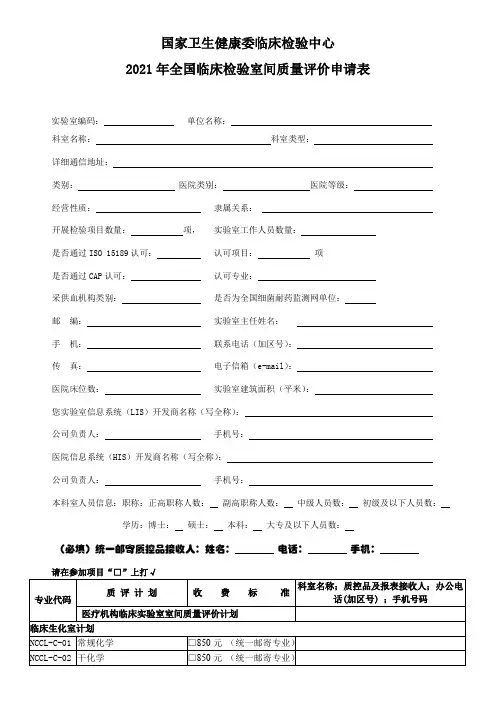
国家卫生健康委临床检验中心
2021年全国临床检验室间质量评价申请表
实验室编码:单位名称:
科室名称:科室类型:
详细通信地址:
类别:医院类别:医院等级:
经营性质:隶属关系:
开展检验项目数量:项,实验室工作人员数量:
是否通过ISO 15189认可:认可项目:项
是否通过CAP认可:认可专业:
采供血机构类别:是否为全国细菌耐药监测网单位:
邮编:实验室主任姓名:
手机:联系电话(加区号):
传真:电子信箱(e-mail):
医院床位数:实验室建筑面积(平米):
您实验室信息系统(LIS)开发商名称(写全称):
公司负责人:手机号:
医院信息系统(HIS)开发商名称(写全称):
公司负责人:手机号:
本科室人员信息:职称:正高职称人数:副高职称人数:中级人员数:初级及以下人员数:学历:博士:硕士:本科:大专及以下人员数:
(必填)统一邮寄质控品接收人:姓名:电话:手机:
请在参加项目“□”上打√
本实验室拟参加以上共个计划的室间质量评价,于月日将所需费用元汇/寄给你处。
发票抬头:统一社会信用代码(纳税人识别号):
汇款单位:汇款人:
联系电话:手机:。
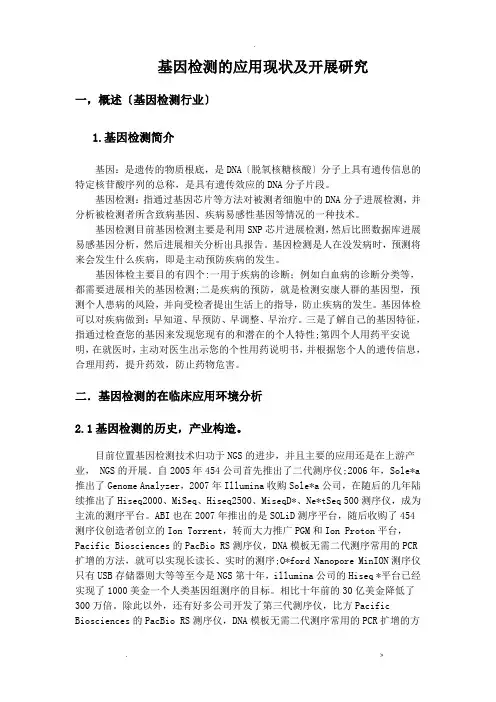
基因检测的应用现状及开展研究一,概述〔基因检测行业〕1.基因检测简介基因:是遗传的物质根底,是DNA〔脱氧核糖核酸〕分子上具有遗传信息的特定核苷酸序列的总称,是具有遗传效应的DNA分子片段。
基因检测:指通过基因芯片等方法对被测者细胞中的DNA分子进展检测,并分析被检测者所含致病基因、疾病易感性基因等情况的一种技术。
基因检测目前基因检测主要是利用SNP芯片进展检测,然后比照数据库进展易感基因分析,然后进展相关分析出具报告。
基因检测是人在没发病时,预测将来会发生什么疾病,即是主动预防疾病的发生。
基因体检主要目的有四个:一用于疾病的诊断;例如白血病的诊断分类等,都需要进展相关的基因检测;二是疾病的预防,就是检测安康人群的基因型,预测个人患病的风险,并向受检者提出生活上的指导,防止疾病的发生。
基因体检可以对疾病做到:早知道、早预防、早调整、早治疗。
三是了解自己的基因特征,指通过检查您的基因来发现您现有的和潜在的个人特性;第四个人用药平安说明,在就医时,主动对医生出示您的个性用药说明书,并根据您个人的遗传信息,合理用药,提升药效,防止药物危害。
二.基因检测的在临床应用环境分析2.1基因检测的历史,产业构造。
目前位置基因检测技术归功于NGS的进步,并且主要的应用还是在上游产业, NGS的开展。
自2005年454公司首先推出了二代测序仪;2006年,Sole*a 推出了Genome Analyzer,2007年Illumina收购Sole*a公司,在随后的几年陆续推出了Hiseq2000、MiSeq、Hiseq2500、MiseqD*、Ne*tSeq 500测序仪,成为主流的测序平台。
ABI也在2007年推出的是SOLiD测序平台,随后收购了454测序仪创造者创立的Ion Torrent,转而大力推广PGM和Ion Proton平台,Pacific Biosciences的PacBio RS测序仪,DNA模板无需二代测序常用的PCR 扩增的方法,就可以实现长读长、实时的测序;O*ford Nanopore MinION测序仪只有USB存储器则大等等至今是NGS第十年,illumina公司的Hiseq *平台已经实现了1000美金一个人类基因组测序的目标。
·视频导读·《中国产前诊断杂志(电子版)》 2020年第12卷第2期犖犐犘犜检测中的意外发现(犜21/犜18/犜13以外的非整倍体、性染色体异常及拷贝数异常)应该常规报告吗?陈兢思(广州医科大学附属第三医院产前诊断科,广东广州 510150)犇犗犐:10.13470/j.cnki.cjpd.2020.02.013 在第九届“中国胎医学大会”上,一场精彩的辩论引起了学员们的极大兴趣,论辩双方就“NIPT检测中的意外发现(T21/18/13以外的非整倍体、性染色体异常及拷贝数变异)是否应该常规报告”展开了激烈的辩论。
来自于广医三院的陈兢思教授认为应该常规报告,主要基于以下3种原因:①国家卫生健康委员会办公厅发布的文件认为对于目标疾病以外的其他异常高风险结果,产前诊断机构应当告知孕妇本人或其家属进行进一步咨询和诊断;②因为有些无明显胎儿表型或胎儿表型不明显的染色体拷贝数异常可能会导致产后发病或死亡,如5pdeletion,22q11.2deletionsyndrome等;③疾病预防作用:可以起到早筛查,早诊断,早干预,对疾病预防起重要作用,并有助于降低出生缺陷的发生。
因此,从疾病预防的角度,应该报告。
当然NIPT筛查也可能带来一些不必要的有创性检测风险,也会增加病人的费用和心理负担,因此,应该充分地知情同意,规范地应用和报告,专业地咨询报告和提供进一步诊断验证。
犖犐犘犜检测中的意外发现(犜21/犜18/犜13以外的非整倍体、性染色体异常及拷贝数异常)不应常规报告贺权泽(苏州市立医院,江苏苏州 215002)犇犗犐:10.13470/j.cnki.cjpd.2020.02.014 与本期另一个视频的观点所相反,来自于苏州市立医院的贺权泽认为NIPT检测中的意外发现不应常规报告。
他认为报与不报是我们在现有医疗水平下,面对高灵敏的检测结果所产生的。
依据何种原则,为患者提供哪些医疗服务,他从产前基因检测的原则和目标:分析有效性、临床准确性、临床实用性和伦理、法律以及社会影响4个方面有理有据地进行论证,认为常规报告NIPT检测中的意外发现、所面临的临床困难,是高灵敏度、高特异度的基因检测技术与有限医学知识之间矛盾的具体表现(可检测但无法提供可预期的预后,以及有针对性的可靠的诊疗手段)。
DOI: 10.1126/science.281.5384.1860, 1860 (1998);281 Science , et al.Howard Y. Chang Adapter Protein Daxx Activation of Apoptosis Signal-Regulating Kinase 1 (ASK1) by theThis copy is for your personal, non-commercial use only.clicking here.colleagues, clients, or customers by , you can order high-quality copies for your If you wish to distribute this article to othershere.following the guidelines can be obtained by Permission to republish or repurpose articles or portions of articles): January 15, 2012 (this infomation is current as of The following resources related to this article are available online at/content/281/5384/1860.full.html version of this article at:including high-resolution figures, can be found in the online Updated information and services, /content/281/5384/1860.full.html#ref-list-1, 4 of which can be accessed free:cites 20 articles This article 386 article(s) on the ISI Web of Science cited by This article has been /content/281/5384/1860.full.html#related-urls 100 articles hosted by HighWire Press; see:cited by This article has been/cgi/collection/cell_biol Cell Biologysubject collections:This article appears in the following registered trademark of AAAS.is a Science 1998 by the American Association for the Advancement of Science; all rights reserved. The title Copyright American Association for the Advancement of Science, 1200 New York Avenue NW, Washington, DC 20005. (print ISSN 0036-8075; online ISSN 1095-9203) is published weekly, except the last week in December, by the Science o n J a n u a r y 15, 2012w w w .s c i e n c e m a g .o r g D o w n l o a d e d f r o mActivation of Apoptosis Signal–Regulating Kinase 1(ASK1)by the Adapter Protein DaxxHoward Y.Chang,*Hideki Nishitoh,*Xiaolu Yang,†Hidenori Ichijo,‡David Baltimore ‡The Fas death receptor can activate the Jun NH 2-terminal kinase (JNK)pathway through the receptor-associated protein Daxx.Daxx was found to activate the JNK kinase kinase ASK1,and overexpression of a kinase-deficient ASK1mutant inhibited Fas-and Daxx-induced apoptosis and JNK activation.Fas activation induced Daxx to interact with ASK1,which consequently relieved an inhibitory intramolecular interaction between the amino-and carboxyl-termini of ASK1,activating its kinase activity.The Daxx-ASK1connection completes a signaling pathway from a cell surface death receptor to kinase cascades that modulate nuclear transcription factors.Fas is a cell surface receptor that induces apoptosis upon oligomerization (1).Fas be-longs to a family of related death receptors,including the receptors for tumor necrosis factor–␣(TNF-␣)and the cytotoxic ligand TRAIL (1,2).Fas-induced apoptosis has a critical role in maintaining peripheral im-mune tolerance (1).Fas can activate two in-dependent signaling pathways.One well-characterized pathway involves the adapter protein FADD,which recruits procaspase-8and activates a protease cascade leading to apoptosis (1,3).The second pathway is me-diated by Daxx,which can enhance Fas-in-duced apoptosis by activating the JNK kinase cascade,culminating in the phosphorylation and activation of transcription factors such as c-Jun (4,5).Because Daxx might activate JNK through a mitogen-activated protein (MAP)kinase kinase kinase (MAP3K)(6–8),we focused on ASK1.It is a MAP3K that can activate apoptosis,is activated by TNF-␣,and the dominant negative form of which can block TNF-␣Ϫinduced death (8).Us-ing an immunoprecipitation (IP)-kinase as-say after expression in human embryonic kidney 293cells (8,9),we found that ASK1activity was potentiated by coex-pression with Daxx (Fig.1A).Another MAP3K that can activate the same kinase cascade,TAK1(6),was not activated by Daxx.The Daxx domain that encodes its JNK activation and apoptotic activities (amino acids 501to 625)and fragments incorporating it (4),but not other parts of Daxx,also increased ASK1activity (Fig.1B).These data implicate ASK1as a down-stream target of Daxx.Consistent with this notion,endogenous ASK1activity was ac-tivated rapidly by Fas cross-linking in a dose-dependent manner in Jurkat cells;lowbut detectable ASK1activation was evident 5min after Fas cross-linking (Fig.1C).To determine the functional role of ASK1in Daxx and Fas signaling,we tested the effect of altering ASK1activity on the apo-ptotic activities of Daxx and Fas (Fig.2).An activated deletion mutant of Daxx,DaxxC501,can induce cell death in a Fas-independent manner in 293cells but not in HeLa cells (4).However,coexpression of ASK1and DaxxC501in HeLa cells synergistically induced apoptosis (Fig.2A).A conser-vative point mutation in the ATP binding loop of ASK1(K709R)completely abro-gated cell killing (Fig.2A).ASK1(K709M),which has less residual kinase activity than ASK1(K709R),inhibited apoptosis by Fas and DaxxC501in a dose-dependent manner (Fig.2,B and C).ASK1(K709M)also in-hibited the ability of DaxxC501and Fas to activate JNK,whereas the caspase inhibitor crmA did not (Fig.2D).Collectively,these results imply a critical role for the ASK1kinase in JNK activation and apoptosis in-duced by Fas binding of Daxx.Because MAP3Ks such as Raf directly interact with upstream signaling proteins (5),we assayed physical interaction between Daxx and ASK1by coimmunoprecipitation from transfected 293T cells.Full-length hu-man Daxx specifically coimmunoprecipitated with ASK1(Fig.3A),indicating that these two proteins physically interact in mammali-H.Y.Chang and X.Yang,Department of Biology,Massachusetts Institute of Technology,Cambridge,MA 02138,USA.H.Nishitoh and H.Ichijo,Depart-ment of Biomaterials Science,Faculty of Dentistry,Tokyo Medical and Dental University,1-5-45Yushi-ma,Bunkyo-ku,Tokyo 113-8549,and Department of Biochemistry,Cancer Institute,Tokyo,Japanese Foun-dation for Cancer Research,1-37-1Kami-Ikebukuro,Toshima-ku,Tokyo 170,Japan.D.Baltimore,Depart-ment of Biology,Massachusetts Institute of Technol-ogy,Cambridge,MA 02138,and California Institute of Technology,Pasadena,CA 91125,USA.*These authors contributed equally to this work.†Present address:Department of Molecular and Cel-lular Engineering and Institute for Human Gene Ther-apy,University of Pennsylvania,Philadelphia,PA 19104,USA.‡To whom correspondence should beaddressed.tion of ASK1.(A )Daxx activates ASK1.pcDNA3-Myc-ASK1(0.5g)or pCS3-Myc-TAK1(0.5g)was cotransfected with pEBB-Daxx (1.5g)into 293cells (23).ASK1and TAK1were im-munoprecipitated by anti-Myc.The immune complex was incubated with GST-MKK6and GST-SAPK/p38␥,and the kinase activity was measured with the substrate ATF2(1–109)peptide.(Top)Phosphorylation of ATF2after in vitro kinase (IVK)assay.(Bottom)Immunoblotting (WB)of immunopre-cipitated Myc-ASK1and Myc-TAK1.Fold activation of ASK1and TAK1kinase activities is indicated below.Kinase activities relative to the amount of ASK1or TAK1proteins were calculated,and the activities are shown as fold activation relative to the activities of ASK1or TAK1from Daxx-negative cells.(B )ASK1activation by Daxx deletion mutants.pcDNA3-FLAG-ASK1(0.5g)and each Daxx mutant (1.5g)were cotransfected into 293cells (left)or HeLa cells (right),and ASK1was immuno-precipitated with anti-FLAG.The immune complex was incubated with GST-MKK6,and then the kinase activity was measured with the substrate GST-SAPK/p38␥(KN).The sequences incorporated in each Daxx construct are as follows:Daxx [amino acids (aa)1to 739],Daxx ⌬C (aa 1to 625),Daxx1–501(aa 1to 501),DaxxC501(aa 501to 739),Daxx501–625(aa 501to 625),DaxxC (aa 626to 739).(Top)Phosphorylation of GST-SAPK3/p38␥(KN).(Bottom)Expression of FLAG-ASK1.Fold activation of ASK1kinase activities is indicated below.(C )Fas-induced activation of ASK1.Jurkat cells (5ϫ106)were treated with CH-11anti-human Fas (MBL,Nagoya,Japan)(100ng/ml)for the indicated times (left)or with the indicated concentrations for 30min (right).The endogenous ASK1was immunoprecipitated with anti-ASK1(DAV)(24),and the ASK1kinase activity was measured as described in (B).18SEPTEMBER 1998VOL 281SCIENCE 1860 o n J a n u a r y 15, 2012w w w .s c i e n c e m a g .o r g D o w n l o a d e d f r o man cells.FLAG-tagged FADD was not copre-cipitated by ASK1under the same condition.To evaluate the observed Daxx-ASK1inter-action under more physiological conditions,we examined the association of endogenous Daxx and ASK1by coimmunoprecipitationin L/Fas cells,a mouse fibroblast cell line expressing murine Fas (4).Daxx became as-sociated with ASK1after Fas ligation byanFig.2.Role of ASK1in Daxx-and Fas-induced apoptosis and signaling.(A )Synthetic lethality of ASK1with DaxxC501.HeLa cells were transfected with 0.5g of pcDNA3-ASK1or pcDNA3-ASK1(K709R)(23)and 1.0g of pEBB-DaxxC501along with 0.5g of pCMV-lacZ reporter by calcium phosphate precipitation.Total amount of transfected DNA was made con-stant by adding vector DNA.Twenty-four hours after transfection,the cells were stained with X-Gal and scored for apoptotic morphology (4).Specific apoptosis was calculated as the percentage of apoptotic blue cells in each experimental condition minus the percentage of apoptotic blue cells (ϳ5%)in parallel vector-transfected cells.The data shown are the mean ϮSD of two to four independent experiments.(B )Inhibition of Fas-induced apopto-sis by ASK1(K709M).HeLa cells were transfected with 0.5g of pEBB-Fas and pCMV-lacZ and the indicated amount (in micrograms)of ASK1(K709M).Jo2antibody (12.5ng/ml)was added 16hours later.X-Gal staining was done at 24hours after transfection.Specific apoptosis was calculated as in (A).(C )Inhibition of DaxxC501-induced apoptosis by ASK1(K709M).pEBB-DaxxC501(2.0g)and the indicated amount (in micro-grams)of pcDNA3-ASK1(K709M)were cotransfected with 0.5g of pCMV-lacZ in 293cells.Twenty hours after transfection the cells were stained with X-Gal and specific apoptosis scored as in (A).(D )Inhibition of DaxxC501-and Fas-induced JNK activation by ASK1(K709M).Expression constructs for each indicated protein (1.0g)were cotransfected with 1.0g of pCMV-FLAG-JNK1in 293cells.Cells in lanes 7to 10were treated with Fas mAb (Jo2,0.5g/ml)for 30min before assay.JNK1was immunoprecipitated with anti-FLAG,and in vitro kinase assay with 1g of GST-cJun(1–79)was performed as described (4).(Top)Phospho-rylation of GST-cJun(1–79).(Bottom)Immunoblotting of immunoprecipitated FLAG-JNK1.Fig.3.Daxx interacts with ASK1.(A )As-sociation of Daxx and ASK1in 293T cells.Four micrograms of pRK5-FLAG-hDaxx,pcDNA3,or pcDNA3-Myc-ASK1(23)were cotransfected with 2.0g of pRK5-crmA in 293T cells by calcium phosphate precipitation.(CrmA prevents the induction of apoptosis and allows the accumulation of tranfected proteins.)After 24hours,cells were extracted in IP-lysis buffer (25),immunoprecipitated with anti-Myc coupled to agarose beads (Santa Cruz)for 3hours at 4°C,and washed three times with 500l of IP-lysis buffer.The IP samples as well as portions of the extracts (10%of IP input)were resolved by SDS-PAGE and immunoblotted with M2anti-FLAG (Kodak)as described (4).(B )Fas-induced interaction of Daxx and ASK1.(Left)Identification of endogenous Daxx protein in L/Fas cells.Lysate from 3ϫ107L/Fas cells was immunoprecipitated with poly-clonal anti-Daxx (DSS)(24)in the absence or presence of blocking peptide (5g/ml)and immunoblotted with DSS.(Right)L/Fas cells (3ϫ107)were treated with mAb Jo2(immunoglobulin G,100ng/ml)(26)for the indicated times (lanes 4to 7)or left untreated (lane 3).Cell lysates were immunoprecipitated with anti-ASK1(lanes 3to 7)and immunoblotted with DSS (top)(25).Equivalent IP of ASK1was confirmed by immunoblotting of the same membrane with anti-ASK1(bottom).(C )Recruitment of endogenous ASK1to Fas.L/Fas cells (1.5ϫ107)were incubated in the presence or absence of Jo2(2g/ml)for 30min at 37°C.Cells were washed once with ice-cold PBS and lysed in IP-lysis buffer.The postnuclear supernatant was immunoprecipitated with 40l of protein A/G-agarose (Santa Cruz)for 3hours at 4°C.In samples that were not first incubated with Jo2,isotype-matched control antibody (2g/ml,lane 1)or Jo2(lane 2)were added after cell lysis.Immunopre-cipitates were washed five times with lysis buffer,resolved by 7.5%SDS-PAGE,and immunoblotted for ASK1with the DAV antiserum.Positions of molecular size standards (in kilodaltons)are shown on the left.(D )Requirement of Daxx for Fas-ASK1interaction.Two micrograms of pcDNA3-ASK1(K709R),1.0g of pCI-AU1-hFas,and 4.0g of pRK5-hDaxxC (23)in the indicated combinations were transfected into 293T cells along with 2.0g of pRK5-crmA and vector DNA as needed to equalize total DNA.Transfected cells were extracted,immunoprecipitated with anti-AU1(Babco)and protein A/G-agarose (Santa Cruz),and immunoblotted for HA-ASK1as in (A).(E )Schematic diagram of ASK1mutants.Amino acid number of domain boundaries is indicated.pcDNA3-⌬N,⌬C,and kinase each contain a COOH-terminal hemagglutinin (HA)epitope tag.pcDNA3-ASKN contains an NH 2-terminal Myc epitope tag (23).(F )Daxx interacts with the NH 2-terminus of ASK1.Four micrograms of each ASK1mutant was cotransfected with 4.0g of pRK5-FLAG-hDaxx and 2.0g of pRK5-crmA in 293T cells.Samples:ASK1(lanes 1and 5);⌬N (lanes 2and 6);⌬C (lanes 3and 7);kinase (lanes 4and 8).Twenty-four hours after transfection cells were extracted in IP-lysis buffer and immunoprecipitated with M2anti-FLAG coupled to agarose beads (Kodak).IP samples and extract aliquots were immunoblotted by anti-HA as in (A).Positions of molecular size standards (in kilodaltons)are shown on theright. SCIENCE VOL 28118SEPTEMBER 19981861o n J a n u a r y 15, 2012w w w .s c i e n c e m a g .o r g D o w n l o a d e d f r o magonistic monoclonal antibody (mAb);this interaction peaked after 15min and decreased thereafter (Fig.3B).The Daxx-ASK1inter-action raised the possibility that ASK1may interact indirectly with Fas through Daxx.In L/Fas cells,the endogenous ASK1was spe-cifically coimmunoprecipitated with Fas after mAb cross-linking (Fig.3C,lane 3),indicat-ing that ASK1does interact with Fas and therefore may be a component of the Fas receptor signaling complex.In contrast,ad-dition of mAb to Fas after cell lysis,which immunoprecipitates monomeric Fas (10),did not coprecipitate ASK1(Fig.3C,lane 2).The Fas-ASK1interaction is apparently mediated by Daxx because coexpression of DaxxC,the COOH-terminal 112amino acid Fas-binding domain of Daxx,blocked the Fas-ASK1in-teraction,presumably by competing out en-dogenous Daxx (Fig.3D,lane 3).The ability of DaxxC to block ASK1recruitment to Fas can explain the documented dominant nega-tive effects of DaxxC on both Fas-induced apoptosis and JNK activation (4).In the yeast two-hybrid system,ASK1interacted with Daxx but not with Fas (11),suggesting that Daxx interacts directly with ASK1and bridg-es ASK1and Fas.Deletion mutagenesis showed that the NH 2-terminal 648amino ac-ids of ASK1,termed ASKN,could interactwith Daxx (Fig.3E and F,lane 7),whereas other parts of ASK1could not interact.Deletion of the NH 2-terminal 648amino acids of ASK1,forming ASK1⌬N,caused the constitutive activation of kinase activity (12)as it does in other MAP3Ks (6).Purified recombinant glutathione S-transferase (GST)–ASKN inhibited the in vitro kinase activity of ASK1but not ASK1⌬N immunoprecipitated from cells (Fig.4A),suggesting that one or more interacting cellular factors regulate ASKN autoinhibition.ASK1⌬N exhibited constitutive cell death activity in HeLa cells in the absence of added Daxx (Fig.4B).Apoptosis induced by ASK1⌬N was quanti-tatively similar to that induced by ASK1plus DaxxC501and was not enhanced by coex-pression with DaxxC501(Fig.4B).These results indicate that an activated allele of ASK1functions as a genetic bypass of Daxx and suggests that with regard to ASK1acti-vation,the function of Daxx is to relieve the inhibition caused by the NH 2-terminal regu-latory domain.We tested this model directly by in vivo interaction assays.ASKN interact-ed with Daxx (Fig.4C,lane 2).It also spe-cifically coimmunoprecipitated ASK1⌬N (Fig.4C,lane 4),implying an intramolecular interaction in full-length ASK1.Importantly,when an excess of Daxx was coexpressedwith ASKN and ASK1⌬N,ASKN associated with Daxx but not ASK1⌬N (Fig.4C,lane 6).This supports a model whereby Daxx activates ASK1activity by displacing an in-hibitory intramolecular interaction between the NH 2-and COOH-termini of the kinase and “opening up”the kinase into an active conformation.In support of this model,ASKN can inhibit the constitutive apoptotic activity of ASK1⌬N in trans,and this inhibi-tion is fully reversed by the coexpression of Daxx (Fig.4D).The present results suggest a Fas-Daxx-ASK1axis in activating JNK and p38MAP kinase cascades.The mechanism by which ASK1is activated by Daxx is similar to that described for the activation of Byr2,a MAP3K in the Schizosaccharomyces pombe mating pheromone pathway,by its activators Ste4and Shk1(13).Fas activation has been reported to activate JNK by caspase-depen-dent (14)and -independent pathways (4,15).During apoptosis,caspases can cleave and activate PAK2and MEKK (16,17),two kinases that can activate the JNK pathway;JNK activation in this context is believed to effect morphologic changes associated with apoptosis (16).The Daxx-ASK1connection provides a mechanism for caspase-indepen-dent activation of JNK by Fas and perhaps other stimuli.In mice deficient for JNK3,hippocampal neurons are protected from ap-optosis after excitotoxic injury,illustrating that in certain circumstances JNK is essential for the apoptotic program (18).In this study,we have used several tumor-derived cell lines where JNK activation by the Fas-Daxx-ASK1axis led to apoptosis.Because FADD -deficient embryonic fibroblasts and T cells are blocked for Fas-induced apoptosis (19),at least in these cells Daxx does not provide an independent death pathway.The physiologic role of the Daxx-ASK1axis and its cell spec-ificity in vivo remain to be addressed.References and Notes1.S.Nagata,Cell 88,355(1997);A.K.Abbas,ibid.84,655(1996).2.P.Golstein,Curr.Biol.7,R750(1997).3.M.P.Boldin,T.M.Goncharov,Y.V.Goltsev,D.Wallach,Cell 85,803(1996);M.Muzio,et al.,ibid.,p.817.4.X.Yang,R.Khosravi-Far,H.Y.Chang,D.Baltimore,ibid.89,1067(1997).5.J.M.Kyriakis and J.Avruch,BioEssay 18,567(1996);C.J.Marshall,Cell 80,279(1995).6.K.Yamaguchi et al.,Science 270,2008(1995).7.L.A.Tibbles et al.,EMBO J.15,7026(1996).8.H.Ichijo et al.,Science 275,90(1997).9.293and HeLa cells were maintained in Dulbecco’s minimum essential medium (DMEM)supplemented with 10%fetal bovine serum (FBS),glucose (4.5g/ml),and penicillin (100U/ml)and transfected with Tfx-50(Promega).Jurkat cells were cultured in RPMI 1640medium containing 10%FBS and antibi-otics in an atmosphere of 5%CO 2at 37°C.SAPK3/p38␥and ATF2peptide (1–109)were provided by M.Goedert and Z.Yao,respectively.Cells were extracted and immunoprecipitated with Myc mAb (Ab-1,Calbiochem),FLAG mAb (M2,Kodak),or antiserum to ASK1(DAV)(19)with protein G(forFig.4.Mechanism of Daxx activation of ASK1.(A )ASKN inhibition of ASK1activity in vitro.pcDNA3-ASK1-HA orpcDNA3-ASK1⌬N-HA were transfected into 293cells and immunoprecipitated with anti-HA (12CA5)and protein A–Sepharose.Equalized input kinase activities were incubated with the indicated amount of GST or GST-ASKN for 60min at 4°C,and subjected to the immune complex kinase assay as described in Fig.1B.G-ASKN,GST-ASKN.(B )Constitutive apoptotic activity of ASK1⌬N.HeLa cells were transfected with 0.5g of each indicated ASK1mutant,1.0g of pEBB or pEBB-DaxxC501,and 0.5g of pCMV-lacZ reporter.Twenty-four after transfection,cells were stained with X-Gal and scored for specific apoptosis as in Fig.2A.(C )Daxx releases the COOH-terminus of ASK1from the NH 2-terminus of ASK1.293T cells were transfected with pcDNA3-Myc-ASKN,pcDNA3-ASK1⌬N,and pRK5-FLAG-hDaxx as indicated along with 2.0g of pRK5-crmA and vector DNA as needed.Two micrograms of each indicated DNA was transfected in lanes 1to 4;in lanes 5and 6,0.5g of ASKN,2.0g of ASK1⌬N,and 4.0g of Daxx were transfected.Transfected cells were extracted,immunoprecipitated with anti-Myc coupled to agarose beads,and immunoblotted with anti-HA and anti-FLAG as in Fig.3A.(D )One microgram each of pcDNA3-ASK1⌬N,pcDNA3-ASKN,and pRK5-FLAG-hDaxx was cotransfected as indicated with 0.5g of pCMV-lacZ and vector DNA as needed in HeLa cells.Twenty-four hours after transfection cells were stained with X-Gal and scored for specific apoptosis as in Fig.2A.18SEPTEMBER 1998VOL 281SCIENCE 1862 o n J a n u a r y 15, 2012w w w .s c i e n c e m a g .o r g D o w n l o a d e d f r o mAb-1or M2)–or protein A (for DAV)–Sepharose.Immune complex assays were performed essential-ly as described (12).Phosphorylation of ATF2pep-tide or GST-SAPK3/p38␥was analyzed by a Fuji BAS2000image analyzer.ASK1or TAK1protein was detected by immunoblotting and enhanced chemiluminescence (ECL),which in exposures less than 10min did not detect 32P radioactivity from kinase autophosphorylation.Protein levels from immunoblot were quantified by densitometry (Quantity One program,pdi).10.F.C.Kischkel et al .,EMBO J.14,5579(1995).11.EGY48yeast strain was tranformed with EG202-ASK1(K709R),pJG4-5vector,pJG4-5-mFas(192–295),or pJG4-5-mDaxx,and JK101reporter plasmids,and quantitative liquid -galactosidase (-Gal)assay was performed (4).Relative -Gal units ϮSD for ASK1(KR)alone,2.4Ϯ0.2;ASK1(KR)plus Daxx,119Ϯ8.8;ASK1(KR)plus Fas,1.8Ϯ0.4.12.M.Saitoh et al .,EMBO J.17,2596(1998).13.H.Tu,M.Barr,D.L.Dong,M.Wigler,Mol.Cell.Biol.17,5876(1997).14.M.A.Cahill et al.,Oncogene 13,2087(1996);F.Toyoshima,T.Moriguchi,E.Nishida.J.Cell Biol.139,1005(1997);S.Huang et al.,Immunity 6,739(1997).15.E.Goillot et al .,Proc.Natl.Acad.Sci.U.S.A.94,3302(1997);H.Wajant et al .,Curr.Biol.8,113(1998).16.T.Rudel and G.M.Bokoch,Science 276,1571(1997);N.Lee et al .,Proc.Natl.Acad.Sci.U.S.A.94,13642(1997).17.M.H.Cardone,G.S.Salvesen,C.Widmann,G.John-son,S.M.Frisch,Cell 90,315(1997).18.D.D.Yang et al .,Nature 389,865(1997).19.W.-C.Yeh,et al .Science 279,1954(1998);J.Zhang,D.Cado,A.Chen,N.H.Kabra,A.Winoto,Nature 392,296(1998).20.H.Hsu,J.Xiong,D.V.Goeddel,Cell 81,495(1995).21.K.Tobiume et al .,mun.239,905(1997).22.Abbreviations for the amino acid residues are as follows:A,Ala;C,Cys;D,Asp;E,Glu;F,Phe;G,Gly;H,His;I,Ile;K,Lys;L,Leu;M,Met;N,Asn;P,Pro;Q,Gln;R,Arg;S,Ser;T,Thr;V,Val;W,Trp;and Y,Tyr.23.pEBB-Daxx (4),Daxx mutants (4),pEBB-Fas (4),pcDNA3-ASK1(8),pcDNA3-ASK1(K709R)(8),Myc-TAK1(6),pCMV-FLAG-JNK1(4),pRK5-crmA (20),EG202-ASK1(K709R)(12),and pJG4-5-mDaxx (4)were as described.ASK1⌬N,⌬C,kinase,FLAG-ASK1,Myc-ASK1,ASK1(K709M)-HA,and Myc-ASKN were constructed in pcDNA3(Invitrogen)by polymerase chain reaction (PCR).FLAG-tagged human Daxx and hDaxxC were derived from EST clone AA085057and constructed in pRK5(20)by PCR.pCI-AU1-hFas was constructed by J.Wang and M.J.Lenardo.The plas-mids of GST–human MKK6,GST SAPK3/p38␥(KN),and GST-ASKN for bacterial fusion protein were con-structed in pGEX-4T-1(Pharmacia Biotech)by PCR.24.Antiserum to ASK1(DAV)was raised to the peptide sequence DAVATSGVSTLSSTVSHDSQ,amino acids 1217to 1236in human ASK1,as described (21).Rabbit polyclonal antibody to mouse Daxx (DSS)was raised against the peptide sequence DSSTRVDSP-SHELVTSSLC (amino acids 680to 698)(22).25.293T cells (2ϫ106)[grown in DMEM supplemented with 10%FBS,penicillin-streptomycin (100U/ml),and glutamine (1mM)]were plated onto a 60-mm dish the day before transfection.Twenty-four hours after transfection,cells were washed once in ice-cold phosphate-buffered saline (PBS)and lysed in 300l of IP-lysis buffer [50mM Hepes (pH 7.4),1%NP-40,150mM NaCl,10%glycerol,1mM EDTA,2mM dithiothreitol]supplemented with 1mM phenyl-methylsulfonyl fluoride and 1%aprotinin.Extract (50l)was diluted in IP-lysis buffer (500l)and immu-noprecipitated with antibody reagents as described in the figure legends.In Fig.3B,L/Fas cells were lysed in 1ml of lysis buffer.Cell lysates were immunoprecipi-tated with antiserum to ASK1through use of protein A–Sepharose.The beads were washed twice with the washing buffer,separated by SDS—polyacrylamide gel electrophoresis (PAGE),and immunoblotted with anti-Daxx (DSS).26.J.Ogasawara et al .,Nature 364,806(1993).27.We are grateful to P.Svec for technical support.We thank S.Nagata,K.Matsumoto,J.Wang,M.J.Le-nardo,D.V.Goeddel,M.Goeddert,and Z.Yao for reagents,and A.Hoffmann for valuable advice and critical review of the manuscript.H.I.thanks K.Miya-zono for valuable discussion.H.Y.C.is supported by the Medical Scientist Training Program at Harvard Medical School.H.I.is supported by Grants-in-Aid forscientific research from the Ministry of Education,Science,and Culture of Japan.X.Y.is a fellow of the Leukemia Society of America.Supported by NIH grant CA51462.16March 1998;accepted 13August 1998Promotion of Dendritic Growth by CPG15,an Activity-InducedSignaling MoleculeElly Nedivi,*†Gang-Yi Wu,Hollis T.ClineActivity-independent and activity-dependent mechanisms work in concert to regulate neuronal growth,ensuring the formation of accurate synaptic con-nections.CPG15,a protein regulated by synaptic activity,functions as a cell-surface growth-promoting molecule in vivo.In Xenopus laevis ,CPG15enhanced dendritic arbor growth in projection neurons,with no effect on interneurons.CPG15controlled growth of neighboring neurons through an intercellular sig-naling mechanism that requires its glycosylphosphatidylinositol link.CPG15may represent a new class of activity-regulated,membrane-bound,growth-promoting proteins that permit exquisite spatial and temporal control of neu-ronal structure.The cpg15gene was identified in a forward genetic approach designed to isolate activity-regulated genes that mediate synaptic plasticity (1).In the adult rat,cpg15is induced in the brain by kainate (KA)and in visual cortex by light (2).During development,cpg15expres-sion is correlated with times of afferent in-growth,dendritic elaboration,and synaptogen-esis (2).Sequence analysis predicts a small,secreted protein (2)that is membrane-bound by a glycosylphosphatidylinositol (GPI)linkage (3).Antiserum generated against bacterially ex-pressed rat CPG15recognizes a protein from rat brain dentate gyrus extracts (Fig.1A)(4)of the size predicted by sequence analysis.A pro-tein of similar size is induced in Xenopus laevis after KA injections into the brain ventricle (Fig.1A)(5).In situ hybridizations using a partial clone of Xenopus cpg15indicate that the CPG15mRNA is expressed in retinal ganglion cells and in differentiated neurons throughout the central nervous system (CNS)of stage-47tadpoles (6).Xenopus CPG15protein is present in neurons and axons throughout the CNS (7,8).In the optic tectum,differentiated neurons label in a honeycomb pattern similar to N-CAM (neural cell adhesion molecule)and other cell-surface antigens,while cells in the proliferativezone have undetectable levels of CPG15(Fig.1C).To investigate the cellular function of CPG15,we used a recombinant vaccinia virus (VV)to express CPG15in optic tectal cells of albino Xenopus tadpoles (9,10).Tadpoles were infected by ventricular injection with VV car-rying rat cpg15and -galactosidase (-gal)cDNAs in a dual promoter vector,or with a control virus containing only the -gal cDNA (11).Two days after viral infection and approx-imately 24hours after the beginning of expres-sion of foreign protein (9),single tectal cells were labeled with DiI (10,12).Confocal imag-es through the entire structure of each neuron were collected at 24-hour intervals over a peri-od of 3days,and three-dimensional (3D)im-ages were reconstructed from this (13).The most prominent effect of CPG15on the morphology of tectal projection neurons was that the dendritic arbors of neurons from CPG15VV-infected animals increased their total dendritic branch length (TDBL)and be-came more complex than arbors of neurons from -gal–infected or uninfected animals (Fig.2)(14).This effect was quantified as an increase in averaged TDBL (Fig.3A)and by Sholl analysis (Fig.3B).We measured the distribution of dendritic arbor sizes,expressed as TDBL,within the population of neurons from CPG15VV-infect-ed animals and from control animals (Fig.3C).All three populations of neurons showed a gradual shift toward larger TDBLs as their dendritic arbors grow.The shift toward larger TDBLs was greatest in neurons from CPG15VV-infected animals.This analysis also demonstrates the presence of a subpopulationCold Spring Harbor Laboratory,1Bungtown Road,Cold Spring Harbor,NY 11724,USA.*To whom correspondence should be addressed.E-mail:nedivi@†Present address:Department of Brain and Cognitive Sciences and Center for Learning and Memory,Mas-sachusetts Institute of Technology,Cambridge,MA 02139,USA. SCIENCE VOL 28118SEPTEMBER 19981863o n J a n u a r y 15, 2012w w w .s c i e n c e m a g .o r g D o w n l o a d e d f r o m。
㊃短篇论著㊃86例无创D N A产前检测假阳性病例原因分析*谢润桂,何怡ә,魏顺娣,张晓燕(东莞市妇幼保健院产前诊断中心,广东东莞523107)摘要:目的探讨无创D N A产前检测(N I P T)在诊断染色体异常中出现假阳性的原因㊂方法选择2016年10月至2018年7月,在东莞市妇幼保健院产前诊断中心做羊水核型分析和染色体微阵列分析技术(C MA)检测确定胎儿染色体正常而N I P T提示染色体异常的假阳性标本86例,在胎儿出生后同时取胎盘组织和母血进行高通量D N A测序分析㊂结果86例N I P T假阳性结果中64例胎盘检测结果与N I P T结果相符,母血结果正常,N I P T假阳性来源于胎盘;12例母血检测结果与N I P T结果相符,胎盘结果正常,N I P T假阳性来源于母体;10例胎盘与母血结果均正常,N I P T假阳性来源不明㊂N I P T检测提示常染色体异常的病例中3.2%N I P T假阳性病例来源于母血,而性染色体异常病例中43.5%N I P T假阳性病例来源于母血㊂结论胎盘和母血中异常游离D N A释放入母血是N I P T假阳性的主要原因㊂对N I P T结果为性染色体异常病例,应排除性染色体异常源自母血的可能性㊂N I P T能够准确检测母血总游离D N A的剂量变化,但无法分辨游离D N A 剂量变化的来源㊂关键词:无创D N A产前检测;假阳性;高通量测序D O I:10.3969/j.i s s n.1673-4130.2019.21.027中图法分类号:R714.15文章编号:1673-4130(2019)21-2671-03文献标识码:B胎儿染色体非整倍体的无创D N A产前检测(N I P T)是利用大规模平行测序技术对母体外周血中的胎儿游离D N A片段(包含胎儿游离D N A)进行深度测序,并将结果进行生物信息分享,可以从中获得胎儿的遗传信息[1]㊂目前N I P T已广泛用于产前筛查,13-三体㊁18-三体和21-三体灵敏度和特异度[2]的检测,但是,同任何筛查方法一样,假阳性和假阴性时常发生㊂通过临床实践与案例研究发现N I P T结果与实际胎儿核型之间存在差异,其发生率在0.1%~ 0.3%㊂该现象的生物学原因主要包括限制性胎盘嵌合㊁双胎一胎凋亡㊁母亲染色体异常㊁D N A拷贝数异常㊁母血中胎儿D N A含量低以及母亲罹患肿瘤等因素[3-5]㊂本文通过分析在东莞市妇幼保健院N I P T检测发现的86例N I P T假阳性病例,在胎儿分娩后留取的胎盘组织及母亲外周血标本,采用高通量测序方法进行验证,探讨N I P T产生假阳性的原因,以及相应的预防措施㊂1资料与方法1.1一般资料选择2016年10月至2018年7月在东莞市妇幼保健院检测出现的N I P T阳性而羊水穿刺核型分析和C MA检测验证胎儿染色体正常的假阳性病例86例㊂在胎儿分娩后留取的胎盘组织及母亲外周血标本,采用高通量测序方法进行验证㊂本研究经东莞市妇幼保健院伦理委员会批准,所有孕妇签署知情同意书㊂1.2方法1.2.1样本采集方法样本采集与孕妇分娩后,采集孕妇静脉血7~10m L,使用C e l l-F r e e D N A B C T 管,采血后颠倒混匀8~10次,24h后进行血浆分离㊂同时进行胎盘组织采样,每个胎盘选6个采样点,在胎盘的胎儿面和母体面分别间隔一定位置表层获取3个黄豆大小(长:0.5~1.0c m,宽:0.5~1.0c m,深: 0.2~0.3c m)的胎盘组织,用少量生理盐水洗净母血,分别按标注置于对应的2m L无菌小型离心管中,最后将标本以-20ħ储存于实验室㊂1.2.2高通量测序检测基因组D N A提取㊁测序文库构建和质量控制,用试剂盒提取基因组D N A,测定基因组D N A浓度,然后在-20ħ保存㊂根据晶芯胎儿染色体非整倍体T21㊁T18㊁T13检测试剂盒的说明进行文库构建㊁质量控制和汇集㊂使用半导体测序仪用于D N A测序㊂测序读数被过滤并与人类参考基因组(H G19)比对㊂1.2.3 N I P T假阳性评估方法 N I P T检测提示染色体异常,而胎儿染色体与羊水核型分析和C MA正常,则判定为N I P T假阳性㊂本研究采用高通量测序法在胎儿出生后同时检测胎盘和母亲外周血中的染色体异常情况,将检测结果与孕期检测的N I P T结果对比,如果N I P T结果与胎盘测定结果一致,则判定㊃1762㊃国际检验医学杂志2019年11月第40卷第21期I n t J L a b M e d,N o v e m b e r2019,V o l.40,N o.21*基金项目:东莞市社会发展科技项目(2018507150071536)㊂ә通信作者,E-m a i l:2378999149@q q.c o m㊂本文引用格式:谢润桂,何怡,魏顺娣,等.86例无创D N A产前检测假阳性病例原因分析[J].国际检验医学杂志,2019,40(21):2671-2673.N I P T假阳性来源于胎盘细胞;如果N I P T结果与母血测定结果一致,则判定N I P T假阳性来源于母体细胞㊂如果两者检测结果正常,无法判定N I P T假阳性的来源,判定为未知来源㊂2结果经高通量测序法检测验证,在86例N I P T假阳性标本中64例胎盘检测结果与N I P T相符,母血结果正常,占74.4%,其中检测结果为性染色异常9例,常染色体异常55例;12例母血检测结果与N I P T结果相符,胎盘结果正常,占14.0%,其中检测结果为性染色异常10例,常染色体异常2例;10例胎盘与母血结果均正常,N I P T假阳性来源不明,占11.6%㊂在64例胎盘来源假阳性病例中有47例为限制性胎盘嵌合,占73.4%㊂N I P T检测提示常染色体异常的63例中2例证实假阳性来源于母血,占3.2%,而性染色体异常23病例中10例假阳性病例来源于母血,占43.5%㊂见表1㊂表186例N I P T假阳性原因验证结果N I P T异常类型胎盘来源母亲来源未知来源合计性染色体异常(n)910423常染色体异常(n)552663染色体异常[n(%)]64(74.4)12(14.0)10(11.6)86(100.0) 3讨论孕妇外周血胎儿游离D N A(c f f D N A)的N I P T是应用高通量基因测序等分子遗传技术检测孕期母体外周血中胎儿游离D N A片段,以评估胎儿常见染色体非整倍体异常风险[6]㊂母体外周血中c f f D N A片段的浓度非常低(3%~6%)[7]㊂c f f D N A具有独特的生理性质:(1)孕妇血浆中的c f f D N A随着孕周的增加而增加[8];(2)c f f D N A均有小片段形式存在,片段长度大都小于300b p;(3)清除速度快,c f f D N A的半衰期为16.3m i n,胎盘娩出后的2h内快速消除[9]㊂N I P T检测母亲外周血中的片段长度为75~250b p 的c f f D N A,并将游离D N A数量定位到染色体相应的位置上,从而得到染色体不同位置D N A数量的比例关系,从而推断染色体是否存在缺失㊁重复或数目异常㊂N I P T结果阳性代表胎儿母亲外周血中的各种c f f D N A的比例关系不正常,可能是与母亲血液系统相连通胎儿滋养层的异常核型细胞引起,也能是由母亲异常核型细胞本身引起,也可能有一部分来源于通过输血㊁免疫治疗㊁器官移植等形式输入体内的外来异常核型细胞导致㊂母体外周血中c f f D N A的来源以及含量变化等生物因素,都会影响N I P T检测准确性,表现为N I P T结果㊁染色体核型分析及C MA结果三者之间存在不一致情况[10-11]㊂N I P T检测的c f f D N A绝大部分来源于胎儿滋养层细胞,胎儿滋养层细胞与胎儿都是由同一个合子发育而来,将发育为胎盘,合子形成后,一部分细胞发育成胎盘的细胞系,一部分细胞发育成胎儿的细胞系㊂正常情况,两者的遗传物质是相同的㊂如果胎盘细胞系的部分细胞出现有丝分裂错误,那么将会出现限制性胎盘嵌合体,即胎盘出现正常与异常的染色体嵌合体,而胎儿核型正常[12]㊂这种情况胎盘滋养层细胞释放c f f D N A的分子剂量会异常,同时引起孕妇血浆中c f f D N A的分子剂量异常,N I P T检测结果显示为阳性,而胎儿染色体是正常的,即出现假阳性结果㊂本研究发现N I P T假阳性大部分来源于胎盘,占74.4%,其中大部分的胎盘来源假阳性病例验证结果提示限制性胎盘嵌合体㊂因此胎盘来源的异常染色体是导致N I P T假阳性的主要原因㊂母体血浆D N A大部分来源于母体基因组,c f f D-N A约占10%~20%[13]㊂虽然在高通量测序前,经过分离和纯化去除了部分的母体基因组D N A,但是如果母血中存在异常D N A,仍会影响c f f D N A的测定,出现假阳性结果㊂性染色体异常在母血中最常见,其中性染色体嵌合是最常见的母体染色体嵌合异常,其发生率1/400[14]㊂由于女性拥有两条X染色体,而且存在剂量补偿和 选择性失活 现象,女性的X染色体异常通常不会引起严重表型,其中X三体㊁嵌合型的X单体或X染色体的结构异常女性一般都有生育能力[15]㊂而对于常染色体异常,数目异常者除21-三体外通常不能存活,也没有生育能力,只有小片段的缺失或者重复携带者才能存活和生育,因此性染色体异常在母体中最常见,性染色体异常携带者比例高是导致母血来源的N I P T假阳性的主要原因㊂本研究中12例母体来源假阳性有10例是X染色体异常,说明X染色体异常在孕妇中携带率最高㊂所以N I P T检测时如果性染色体异常,很可能来源于母血,应同时对母体白细胞进行染色体检测,以排除母体来源的可能,将会提高N I P T对性染色体检测结果的准确性,避免病人妊娠期间不必要的紧张和压力㊂本研究还有10例假阳性病例同时检测了胎盘组织和母血均正常,N I P T假阳性来源不明㊂N I P T检测一般在孕早中期距离分娩有6㊁7个月时间,引起N I P T假阳性的异常c f f D N A可能已经消失了,因此,本方法无法找到引起N I P T假阳性原因㊂对游离D N A剂量变化的来源检测还需要进一步提高现有检测技术㊂高通量测序法验证发现胎盘和母血中异常游离D N A释放入母血是N I P T假阳性的主要原因㊂对N I P T结果为性染色体异常病例,应排除性染色体异常源自母血的可能性㊂N I P T能够准确检测母血总游离D N A的剂量变化,但无法分辨游离D N A剂量变化的来源㊂参考文献[1]边旭明.胎儿染色体非整倍体的无创D N A产前检测[J].㊃2762㊃国际检验医学杂志2019年11月第40卷第21期I n t J L a b M e d,N o v e m b e r2019,V o l.40,N o.21实用妇产科杂志,2013,29(5):330-333.[2]B I A N C H I D W,R A V A R P,S E HN E R T A J.D N A S e-q u e n c i n g v e r s u s S t a n d a r d P r e n a t a l A n e u p l o i d y S c r e e n i n g [J].N E n g l J M e d,2014,371(6):887-888.[3]B I A N C H I D W.C h e r c h e z l a f e mm e:m a t e r n a l i n c i d e n t a lf i n d i ng s c a n e x p l a i n d i s c o r d a n t p r e n a t a l c e l l-f r e e D N A s e-q u e n c i n g r e s u l t s[J].G e n e t M e d,2017,20(9):910-917.[4]B R I S O N N,V A N D B K,e t a l.A c c u r a c y a n d c l i n i c a l v a l-u e o f m a t e r n a l i n c i d e n t a l f i n d i n g s d u r i n g n o n i n v a s i v e p r e-n a t a l t e s t i n g f o r f e t a l a n e u p l o i d i e s[J].G e n e t M e d,2017, 72(8):469-470.[5]C U R N O W K J,W I L K I N S-H A U G L,R Y A N A,e t a l.D e t e c-t i o n o f t r i p l o i d,m o l a r,a n d v a n i s h i n g t w i n p r e g n a n c i e s b y a s i n-g l e-n u c l e o t i d e p o l y m o r p h i s m-b a s e d n o n i n v a s i v e p r e n a t a l t e s t[J].A m J O b s t e t G y n e c o l,2015,212(1):1-9.[6]刘俊涛.无创产前检测国际指南与中国规范[J].中国实用妇科与产科杂志,2017(6):16-19.[7]L O Y M,T E I N S C,L A U T K,e t a l.Q u a n t i t a t i v e a n a l y-s i s o f f e t a l D N A i n m a t e r n a l p l a s m a a n d s e r u m:i m p l i c a-t i o n s f o r n o n i n v a s i v e p r e n a t a l d i a g n o s i s[J].A m J H u mG e n e t,1998,62(4):768-775.[8]C HU I D H K,C U N N I N G HAM M J,L U O H,e t a l.S c r e e n i n g a n d c o u n s e l i n g f o r t h a l a s s e m i a[J].B l o o d, 2006,107(4):1735-1737.[9]N I C O L A I D E S K H,S Y N G E L A K I A,A S HO O R G,e t a l.N o n i n v a s i v e p r e n a t a l t e s t i n g f o r f e t a l t r i s o m i e s i n a r o u-t i n e l y s c r e e n e d f i r s t-t r i m e s t e r p o p u l a t i o n[J].A m J O b s t e tG y n e c o l,2012,207(5):1-6.[10]B I A N C H I D W,W I L K I N S-HA U G L.I n t e g r a t i o n o f n o n-i n v a s i v e D N A t e s t i n g f o r a n e u p l o i d y i n t o p r e n a t a l c a r e:w h a t h a s h a p p e n e d s i n c e t h e r u b b e r m e t t h e r o a d[J].C l i nC h e m,2014,60(1):78-87.[11]WA N G J C,S A HO O T,S C HO N B E R G S,e t a l.D i s c o r d-a n t n o n i n v a s i v e p r e n a t a l t e s t i n g a n d c y t o g e n e t i c r e s u l t s:a s t u d y o f109c o n s e c u t i v e c a s e s[J].G e n e t M e d,2015,17(3):234-236.[12]L E S T O U V S,K A L O U S E K D K.C o n f i n e d p l a c e n t a l m o-s a i c i s m a n d i n t r a u t e r i n e f e t a l g r o w t h[J].A r c h D i s C h i l dF e t a l N e o n a t a l E d,1998,79(3):223-226.[13]A C O G.C e l l-f r e e D N A s c r e e n i n g f o r f e t a l a n e u p l o i d y.C o mm i t t e e o p i n i o n N o.640[J].O b s t e t G y n e c o l,2015,126(3):691-692.[14]G R A T I F R,B A R L O C C O A,G R I M I B,e t a l.C h r o m o-s o m e a b n o r m a l i t i e s i n v e s t i g a t e d b y n o n-i n v a s i v e p r e n a t a l t e s t i n g a c c o u n t f o r a p p r o x i m a t e l y50%o f f e t a l u n b a l-a n c e s a s s o c i a t e d w i t h r e l e v a n t c l i n i c a l p h e n o t y p e s[J].A mJ M e d G e n e t A,2010,152A(6):1434-1442. [15]朱蔚云,谢天炽,李佩琼,等.人类X染色体失活与基因的剂量补偿效应[J].中国优生与遗传杂志,2017(11):61-63.(收稿日期:2019-03-10修回日期:2019-05-22)㊃短篇论著㊃1203例不育患者的精子D F I与精液质量参数的相关性分析*李清琴,董荔红ә,吴丹梅,钟福春,张朵(联勤保障部队第九〇〇医院临床遗传与实验医学科,福建福州350025)摘要:目的分析不育患者精液质量㊁年龄与精子D N A断裂指数(D F I)的关系,探讨精子D N A损伤的机制㊂方法回顾性分析1203例不育患者的精子D F I㊁精子浓度㊁活力和年龄等指标㊂按少㊁弱精子症进行分组,并进行精子D F I与精子浓度㊁活力的相关性分析㊂结果精子D F I与精子浓度无相关性,而与精子活力呈负相关(r=-0.457,P<0.05)㊂少㊁弱精子症组的D F I较正常组高,各组间比较差异有统计学意义(P< 0.05)㊂年龄与精子D F I呈正相关(r=0.172,P<0.05),在弱精子症组中,不同年龄组D F I值比较差异有统计学意义(P<0.05)㊂结论精子D F I在弱精子症患者中明显升高,其升高水平与精子活力下降的程度有明显的相关性㊂年龄与精子D F I呈正相关㊂关键词:精子D N A断裂指数;不育;精子活力;年龄D O I:10.3969/j.i s s n.1673-4130.2019.21.028中图法分类号:R698+.2文章编号:1673-4130(2019)21-2673-04文献标识码:B据统计中国育龄夫妇中受不育不孕困扰的大约有10%~15%,其中男性因素约占50%[1]㊂精子核D N A完整性,是父源性遗传信息能否准确传递给后代的关键㊂约20%的特发性不育症存在精子D N A㊃3762㊃国际检验医学杂志2019年11月第40卷第21期I n t J L a b M e d,N o v e m b e r2019,V o l.40,N o.21*基金项目:第九〇〇医院临床应用研究专项基金(2017L01)㊂ә通信作者,E-m a i l:77841892@q q.c o m㊂本文引用格式:李清琴,董荔红,吴丹梅,等.1203例不育患者的精子D F I与精液质量参数的相关性分析[J].国际检验医学杂志,2019,40 (21):2673-2676.。
附件1 胎儿染色体非整倍体(T21、T18、T13)
检测试剂盒(高通量测序法)技术审查 指导原则(征求意见稿)
一、前言 本指导原则旨在指导注册申请人对胎儿染色体非整倍体(T21、T18、T13)检测试剂盒(高通量测序法)注册申报资料的准备及撰写,同时也为技术审评部门对注册申报资料的技术审评提供参考。 本指导原则是对该类试剂的一般要求,申请人应依据产品的具体特性确定其中内容是否适用,若不适用,需具体阐述理由及相应的科学依据,并依据产品的具体特性对注册申报资料的内容进行充实和细化。如申请人认为有必要增加本指导原则未包含的研究内容,可自行补充。 本指导原则是对申请人和审查人员的指导性文件,但不包括注册审批所涉及的行政事项,亦不作为法规强制执行,如果有能够满足相关法规要求的其他方法,也可以采用,但需要提供详细的研究资料和验证资料,相关人员应在遵循相关法规的前提下使用本指导原则。 本指导原则是在现行法规和标准体系以及当前认知水平下制定的,随着法规和标准的不断完善,以及科学技术的不断发展,本指导原则相关内容也将适时进行调整。 二、适用范围 (一)临床背景 胎儿染色体非整倍体(fetal chromosome aneuploidies)中的21三体、18三体、13三体(trisomies 21、18、13,即T21、T18、T13)是临床上最常见的染色体非整倍体疾病。其对应的分别21-三体综合征(又称唐氏综合征,先天愚型或Down综合征)、18-三体综合征(又称Edwards综合征)和13-三体综合征(又称Patau综合征),发病率分别约为1/700、1/6000、1/10000,患儿绝大多数存在严重智力障碍及器官畸形,生活无法自理,不仅影响儿童的生命健康和生活质量,同时影响经济社会的健康可持续发展。 依据《中华人民共和国母婴保健法》,为了保障母亲和婴儿健康,提高出我国出生人口素质,医疗保健机构应当为育龄妇女和孕产妇提供孕产期保健服务。产前筛查和产前诊断即是为避免产生遗传缺陷患儿提供的有效手段。常规的产前筛查方法包括:早孕期的超声与血清学联合筛查和中孕期母体血清学筛查。中孕期母体血清学筛查是指通过中孕期母体血清甲胎蛋白、血清人绒毛膜促性腺激素、血清人绒毛膜促性腺激素游离ß亚基、抑制素A和非结合雌三醇指标结合孕妇的年龄、体重、孕周、病史等进行综合风险评估,得出胎儿是否罹患相关三体综合征或神经管缺陷的风险度。筛查结果为高风险的孕妇经建议经产前诊断进行最终确认,由孕妇知情选择。胎儿染色体异常的产前诊断金标准为介入前产前诊断手术,是指通过绒毛取材术/羊膜腔穿刺术/经皮脐血管穿刺术,取相应细胞采用细胞生物学方法对胎儿染色体进行核型分析。 我国对以下孕妇均实行产前诊断:35岁以上的高龄孕妇;产前筛查出来的胎儿染色体异常高风险的孕妇;曾生育过染色体病患儿的孕妇;产前B超检查怀疑胎儿可能有染色体异常的孕妇;夫妇一方为染色体异常携带者;医师认为有必要进行产前诊断的其他情形。 (二)高通量测序法进行产前筛查 高通量测序(High-Throughput Sequencing)是近年来迅速发展的测序技术,又称做下一代测序(NGS,Next Generation Sequencing)或大规模平行测序(MPSS,massively parallel signature sequencing)。相较于以Sanger测序为代表的第一代测序技术,其检测通量高,灵敏度高,速度快,随着近年来检测成本的降低,逐渐由科研转入临床应用研究。但从检测的准确性上说,第一代测序技术目前仍然是测序检测的金标准。 从全球范围看,高通量测序在临床应用最广的方面为胎儿染色体非整倍体的产前筛查。其原理是:孕妇母体血浆中存在胎儿游离DNA(cffDNA,cell-free fetal DNA), 长度约为75bp-250bp,几乎全部来源于胎盘的滋养层细胞,其浓度和孕周密切相关并以一定比例(5%-30%)稳定存在于母体外周血浆中。取母体血浆提取包含正常母体和胎儿的血浆游离DNA,通过文库构建技术,经过片段扩增,最后进行上机测序,通过软件分析数据获得染色体数目评价结果。当对怀有T21胎儿的母体血浆游离DNA数据进行分析时,其21号染色体游离DNA总数会有小比例的升高,通过统计学算法区分这一微小差异来实现利用cffDNA进行胎儿染色体非整倍体的产前筛查。但高通量测序法不能对染色体结构异常进行检测,不能代替传统筛查中的开放式神经管缺陷筛查等。 (三)适用范围 本指导原则所述的高通量测序法,指的是通过文库构建、片段扩增进而进行上机测序的第二代高通量测序方法,不需要进行片段扩增的第三代、第四代单分子测序方法在文中并未涉及。但高通量测序技术发展迅速,第三代、第四代单分子测序方法如果在企业内部参考品设置、性能评估或临床评价等处如有适用的方面,可以参照执行。 适用人群:本指导原则预期用途为对孕周12周(包含12周)以上的孕妇进行产前筛查,其结果不能代表对孕妇怀有三体胎儿的确认,产前筛查的结果必须要经过产前诊断进行确认。 伦理学问题:终止妊娠应在遵守我国相关法律法规和行业规定的前提下由医师提出建议,由夫妻双方知情选择,该项检测不得作为终止妊娠的依据。 三、基本要求 (一)综述资料
综述资料主要包括产品预期用途、产品描述、有关生物安全性的说明、有关产品主要研究结果的总结和评价以及其他等内容,其中其他包括同类产品在国内外批准上市的情况,应着重从方法学及检出限等方面写明拟申报产品与目前市场上已获批准的同类产品之间的主要区别。应符合《体外诊断试剂注册管理办法》(总局令第5号)和《体外诊断试剂注册申报资料要求及说明》(国家食品药品监督管理总局公告2014年第44号)的相关要求。 综述资料应详细阐明检测原理,可配合图示并写明一个完整检测配合使用的全部试剂及耗材名称、生产厂家、货号或注册证书号以及详细的组成成分。 (二)主要原材料的研究资料 主要原材料的研究资料包括企业内部参考品和完成检测所需试剂组成两部分。 1. 企业内部参考品应至少包括:阳性参考品、阴性参考品、检测限参考品、嵌合体参考品,具体要求如下: 1.1阳性参考品:应采用T21、T18、T13胎儿DNA片段按一定比例与正常女性血浆混合的模拟样本,T21、T18、T13胎儿DNA片段可由流产组织或羊水细胞等来源制备。 1.2阴性参考品:应包括采用染色体数目正常胎儿DNA片段按一定比例与正常女性血浆混合的模拟样本,以及采用其他染色体异常胎儿DNA片段按一定比例与正常女性血浆混合的模拟样本。其他染色体异常的阴性参考品由申请人依据常见染色体异常项目并根据对产品的质控要求自行选择。 1.3检测限参考品:应采用T21、T18、T13胎儿DNA片段按不同比例梯度与正常女性血浆混合的模拟样本,如5%、3.5%、2.5%等,建议采用95%(n≥20)的阳性检出率作为最低检测限确定的标准。 1.4嵌合体参考品:由申请人按照对产品的质控要求自行设定模拟T21、T18和T13嵌合体的组成比例,如70%异常,30%正常;30%异常,70%正常等。 申请人应详细说明企业内部参考品的组成、详细说明制备及检定方法、胎儿DNA片段浓度确认方式和所占比例的选择依据。企业内部参考品中各类型均应设置多个重复。 2. 完成全部检测流程所需试剂应至少包括:血浆游离DNA提取纯化试剂、文库构建试剂、文库定量试剂、测序试剂、阴、阳性质控品,以及与之配合使用的测序芯片和数据分析软件。具体要求如下: 2.1血浆游离DNA提取纯化试剂:该试剂分类界定为一类试剂,无论申报产品中包含或是配合使用,申请人均应提供该试剂提取纯化原理、生产厂家及货号或一类备案凭证号,提交详细组成成分资料。性能方面需对该试剂提取的DNA片段准确性及纯度要求,提取效率、重复性及抗干扰能力进行评估。 2.2文库构建试剂、文库定量试剂、测序试剂:文库构建试剂通过对片段化的DNA进行缺口补平及相应部分5’端磷酸化和3’端去磷酸化之后使用连接酶加上用于测序和分析的标签和接头,构建成可以用来测序上机的标准文库;文库定量试剂通过PCR扩增及与标准品曲线的比对,用于定量测定文库浓度,为后续均一化文库进行上机测序做准备,同时能够评估文库构建的质量。文库定量时应明确对文库质量、片段大小及浓度要求,应提供分析图谱,对其中参数进行解释说明(如是否有杂峰,产生的原因,是否对最终结果产生影响等);测序试剂用于对均一化的文库进行片段扩增,通过基因测序仪捕捉扩增过程中碱基的变化引起的信号变化来达到读取序列的目的。 以上三种试剂一般由:相应功能的酶(末端修复酶、DNA连接酶、缺口修复酶DNA聚合酶等)、核苷酸序列(引物、接头序列、标签序列、文库定量标准品)、缓冲液及dNTP组成。具体要求如下: 2.2.1酶:应提交纯度、活性和稳定性资料,提交功能性试验资料。例如:文库构建过程包括但不限于末端修复酶、DNA连接酶、缺口修复聚合酶等,所选择的酶应当具有末端突出削平、缺口补平、标签或接头连接、DNA聚合酶活性; 2.2.2核苷酸序列:应提交相应的序列组成和纯度信息,序列准确度及稳定性资料;引物设计应提交引物设计原则及选择对比依据; 2.2.3缓冲液:缓冲液应明确详细的组成及各盐浓度选择对比的依据; 2.2.4 dNTP:包括dATP、dGTP、dCTP、dTTP,应提交对纯度、浓度、保存稳定性等的详细验证资料。 2.3阴、阳性质控品:须能够监控DNA片段提取到最终测序结果全过程,因此应当由阴、阳性(T21、T18和T13)胎儿DNA片段按已知比例与正常女性血浆基质混合组成。 2.4测序芯片:应详细阐明芯片进行片段扩增原理及结构,明确使用芯片型号,并对同一次测序芯片上样的样本间精密度进行评价。 2.5数据分析软件:举例介绍原始数据质量评估、数据处理和筛选的方法,明确数据筛选依据以及使用的算法。 2.6除上述材料外,还需提交不同原材料对于最终测序数据